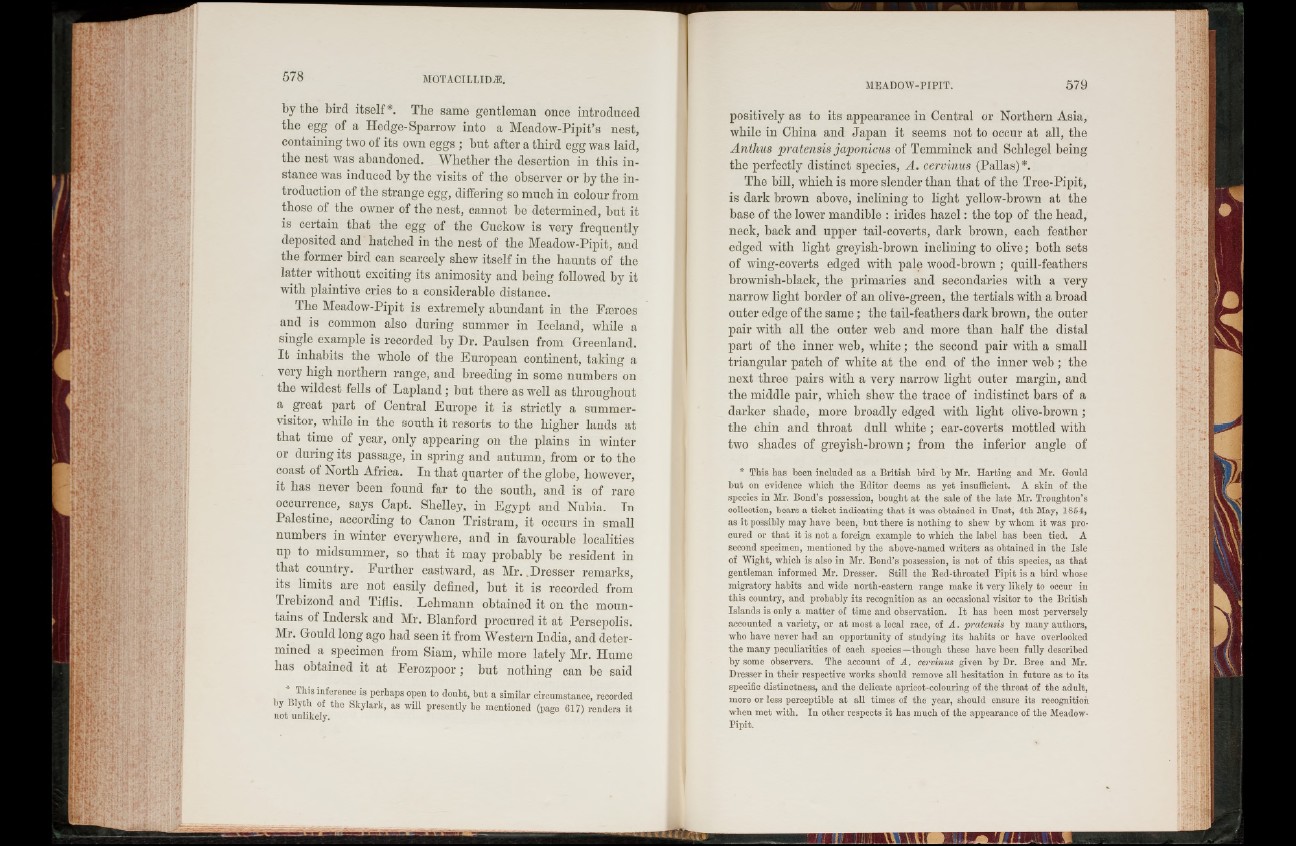
by the bird itself*. The same gentleman once introduced
the egg of a Hedge-Sparrow into a Meadow-Pipit’s nest,
containing two ol its own eggs ; but after a third egg was laid,
the nest was abandoned. Whether the desertion in this in stance
was induced by the visits of the observer or by the introduction
of the strange egg, differing so much in colour from
those of the owner of the nest, cannot be determined, but it
is certain that the egg of the Cuckow is very frequently
deposited and hatched in the nest of the Meadow-Pipit, and
the former bird can scarcely shew itself in the haunts of the
latter without exciting its animosity and being followed by it
with plaintive cries to a considerable distance.
The Meadow-Pipit is extremely abundant in the Faroes
and is common also during summer in Iceland, while a
single example is recorded by Dr. Paulsen from Greenland.
I t inhabits the whole of the European continent, taking a
very high northern range, and breeding in some numbers on
the wildest fells of Lapland; but there as well as throughout
a great part of Central Europe it is strictly a summer-
visitor, while in the south it resorts to the higher lands at
that time of year, only appearing on the plains in winter
or during its passage, in spring and autumn, from or to the
coast of North Africa. In that quarter of the globe, however,
it has never been found far to the south, and is of rare
occurrence, says Capt. Shelley, in Egypt and Nubia. In
Palestine, according to Canon Tristram, it occurs in small
numbers in winter everywhere, and in favourable localities
up to midsummer, so that it may probably be resident in
that country. Further eastward, as Mr. .Dresser remarks,
its limits are not easily defined, but it is recorded from
Trebizond and Tiflis. Lehmann obtained it on the mountains
of Indersk and Mr. Blanford procured it at Persepolis.
Mr. Gould long ago had seen it from Western India, and determined
a specimen from Siam, while more lately Mr. Hume
has obtained it at Ferozpoor; but nothing can be said
* This inference is perhaps open to doubt, but a similar circumstance, recorded
by Blyth of the Skylark, as will presently be mentioned (page 617) renders it
not unlikely.
positively as to its appearance in Central or Northern Asia,
while in China and Japan it seems not to occur at all, the
Anthus pratensis japonictis of Temminck and Schlegel being
the perfectly distinct species, A. cervinus (Pallas)*.
The bill, which is more slender than that of the Tree-Pipit,
is dark brown above, inclining to light yellow-brown at the
base of the lower mandible : irides hazel: the top of the head,
neck, back and upper tail-coverts, dark brown, each feather
edged with light greyisli-brown inclining to olive; both sets
of wing-coverts edged with pale wood-brown ; quill-feathers
brownish-black, the primaries and secondaries with a very
narrow light border of an olive-green, the tertials with a broad
outer edge of the same; the tail-feathers dark brown, the outer
pair with all the outer web and more than half the distal
part of the inner web, white; the second pair with a small
triangular patch of white at the end of the inner web; the
next three pairs with a very narrow light outer margin, and
the middle pair, which shew the trace of indistinct bars of a
darker shade, more broadly edged with light olive-brown;
the chin and throat dull white ; ear-coverts mottled with
two shades of greyish-brown; from the inferior angle of
* This has been included as a British bird by Mr. Harting and Mr. Gould
but on evidence which the Editor deems as yet insufficient. A skin of the
species in Mr. Bond’s possession, bought at the sale of the late Mr. Troughton’s
collection, bears a ticket indicating that it was obtained in Unst, 4th May, 1854,
as it possibly may have been, but there is nothing to shew by whom it was procured
or that it is not a foreign example to which the label has been tied. A
second specimen, mentioned by the above-named writers as obtained in the Isle
of Wight, which is also in Mr. Bond’s possession, is not of this species, as that
gentleman informed Mr. Dresser. Still the Red-throated Pipit is a bird whose
migratory habits and wide north-eastern range make it very likely to occur in
this country, and probably its recognition as an occasional visitor to the British
Islands is only a matter of time and observation. I t has been most perversely
accounted a variety, or a t most a local race, of A. 'pratensis by many authors,
who have never had an opportunity of studying its habits or have overlooked
the many peculiarities of each species—though these have been fully described
by some observers. The account of A, cervinus given by Dr. Bree and Mr.
Dresser in their respective works should remove all hesitation in future as to its
specific distinctness, and the delicate apricot-colouring of the throat of the adult,
more or less perceptible a t all times of the year, should ensure its recognition
when met with. In other respects it has much of the appearance of the Meadow-
Pipit.